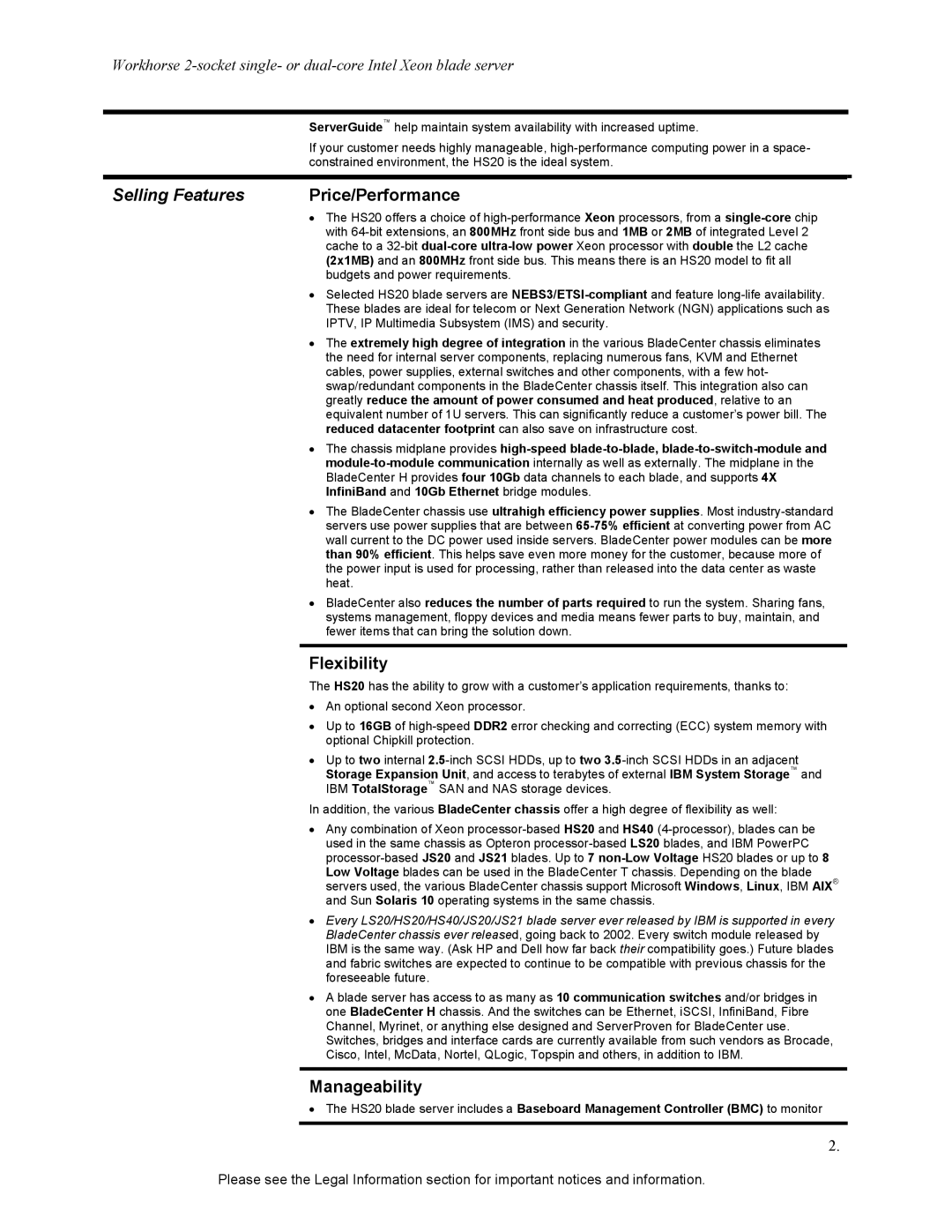
Workhorse
| ServerGuide™ help maintain system availability with increased uptime. |
| If your customer needs highly manageable, |
| constrained environment, the HS20 is the ideal system. |
|
|
Selling Features | Price/Performance |
| • The HS20 offers a choice of |
| with |
| cache to a |
| (2x1MB) and an 800MHz front side bus. This means there is an HS20 model to fit all |
| budgets and power requirements. |
| • Selected HS20 blade servers are |
| These blades are ideal for telecom or Next Generation Network (NGN) applications such as |
| IPTV, IP Multimedia Subsystem (IMS) and security. |
| • The extremely high degree of integration in the various BladeCenter chassis eliminates |
| the need for internal server components, replacing numerous fans, KVM and Ethernet |
| cables, power supplies, external switches and other components, with a few hot- |
| swap/redundant components in the BladeCenter chassis itself. This integration also can |
| greatly reduce the amount of power consumed and heat produced, relative to an |
| equivalent number of 1U servers. This can significantly reduce a customer’s power bill. The |
| reduced datacenter footprint can also save on infrastructure cost. |
| • The chassis midplane provides |
| |
| BladeCenter H provides four 10Gb data channels to each blade, and supports 4X |
| InfiniBand and 10Gb Ethernet bridge modules. |
| • The BladeCenter chassis use ultrahigh efficiency power supplies. Most |
| servers use power supplies that are between |
| wall current to the DC power used inside servers. BladeCenter power modules can be more |
| than 90% efficient. This helps save even more money for the customer, because more of |
| the power input is used for processing, rather than released into the data center as waste |
| heat. |
| • BladeCenter also reduces the number of parts required to run the system. Sharing fans, |
| systems management, floppy devices and media means fewer parts to buy, maintain, and |
| fewer items that can bring the solution down. |
|
|
| Flexibility |
| The HS20 has the ability to grow with a customer’s application requirements, thanks to: |
| • An optional second Xeon processor. |
| • Up to 16GB of |
| optional Chipkill protection. |
| • Up to two internal |
| Storage Expansion Unit, and access to terabytes of external IBM System Storage™ and |
| IBM TotalStorage™ SAN and NAS storage devices. |
| In addition, the various BladeCenter chassis offer a high degree of flexibility as well: |
| • Any combination of Xeon |
| used in the same chassis as Opteron |
| |
| Low Voltage blades can be used in the BladeCenter T chassis. Depending on the blade |
| servers used, the various BladeCenter chassis support Microsoft Windows, Linux, IBM AIX® |
| and Sun Solaris 10 operating systems in the same chassis. |
| • Every LS20/HS20/HS40/JS20/JS21 blade server ever released by IBM is supported in every |
| BladeCenter chassis ever released, going back to 2002. Every switch module released by |
| IBM is the same way. (Ask HP and Dell how far back their compatibility goes.) Future blades |
| and fabric switches are expected to continue to be compatible with previous chassis for the |
| foreseeable future. |
| • A blade server has access to as many as 10 communication switches and/or bridges in |
| one BladeCenter H chassis. And the switches can be Ethernet, iSCSI, InfiniBand, Fibre |
| Channel, Myrinet, or anything else designed and ServerProven for BladeCenter use. |
| Switches, bridges and interface cards are currently available from such vendors as Brocade, |
| Cisco, Intel, McData, Nortel, QLogic, Topspin and others, in addition to IBM. |
|
|
Manageability
•The HS20 blade server includes a Baseboard Management Controller (BMC) to monitor
2.
Please see the Legal Information section for important notices and information.
